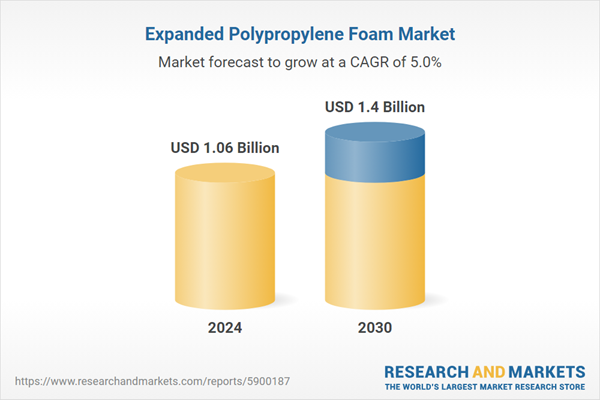Speak directly to the analyst to clarify any post sales queries you may have.
10% Free customizationThis report comes with 10% free customization, enabling you to add data that meets your specific business needs.
Its growing adoption in the automotive industry - particularly in components such as bumpers, headrests, and door panels - has been a major driver, as the material aids in reducing vehicle weight and emissions, key priorities amid stricter global environmental regulations. The accelerating shift toward electric vehicles further fuels demand, given EPP’s role in improving energy efficiency and safety. Ongoing advancements in molding technology and material engineering are expanding the application potential of EPP foam across diverse sectors. With rising global emphasis on sustainability and circular economy practices, the market is expected to grow steadily as industries seek recyclable, high-performance materials.
Key Market Drivers
Growing Demand of Expanded Polypropylene Foam in Automotive Industry
The automotive industry’s increasing emphasis on lightweight materials to meet emission regulations and enhance fuel efficiency is driving demand for EPP foam. EPP’s ability to absorb energy and resist multiple impacts makes it ideal for use in safety-critical components like bumpers and interior parts. One notable material, ARPRO, is widely used for its lightweight nature, high energy absorption, chemical resistance, and thermal insulation. Its full recyclability supports environmental goals while delivering high performance. As automotive production continues to expand and automakers aim to reduce vehicle weight without compromising safety, EPP foam is becoming a material of choice. These characteristics are particularly valuable in electric and hybrid vehicles, where weight reduction directly impacts battery efficiency and range.Key Market Challenges
Volatility in Prices of Raw Materials
One of the primary challenges for the EPP foam market is the fluctuation in raw material prices, particularly for propylene. As a petroleum-based derivative, propylene prices are sensitive to oil market dynamics, supply chain issues, and geopolitical factors. These fluctuations directly influence production costs and pricing stability for EPP foam. Increased costs may be passed down the supply chain, potentially affecting end-user demand, especially in cost-sensitive sectors. Price instability also complicates investment planning and production scaling for manufacturers. The lack of price predictability may deter companies from expanding capacity or investing in R&D, thereby limiting innovation and growth potential. To address this, manufacturers are exploring cost optimization strategies, alternative sourcing, and material efficiency improvements.Key Market Trends
Advancements in Processing Technology
Ongoing innovation in processing technology is playing a crucial role in improving the quality and efficiency of EPP foam production. New manufacturing methods, such as the advanced extrusion process developed by Sulzer Chemtech and Borealis, offer enhanced control over properties like density and bead size, allowing for more tailored applications. Injection molding and steam chest molding techniques are enabling the production of complex shapes with consistent quality. Automation, robotics, and AI are also being increasingly adopted to improve accuracy, reduce defects, and boost throughput. Additionally, IoT-based systems are providing real-time data for operational optimization, helping manufacturers reduce waste and enhance process control. These innovations are not only improving performance but also supporting environmental goals by minimizing material usage and energy consumption.Key Market Players
- BASF SE
- KANEKA CORPORATION
- FURUKAWA ELECTRIC CO., LTD.
- Sonoco Products Company
- DONGSHIN INDUSTRY INCORPORATED
- Clark Foam Products Corporation
- Paracoat Products Ltd.
- IZOBlok SA
- Signode Industrial Group LLC
- Armacell, LLC
Report Scope:
In this report, the Global Expanded Polypropylene Foam Market has been segmented into the following categories, in addition to the industry trends which have also been detailed below:Expanded Polypropylene Foam Market, By Type:
- Low Density
- High Density
- Porous Polypropylene
Expanded Polypropylene Foam Market, By Application:
- Automotive
- Packaging
- Consumer Products
- Others
Expanded Polypropylene Foam Market, By Region:
- North America
- United States
- Canada
- Mexico
- Europe
- France
- United Kingdom
- Italy
- Germany
- Spain
- Asia Pacific
- China
- India
- Japan
- Australia
- South Korea
- South America
- Brazil
- Argentina
- Colombia
- Middle East & Africa
- South Africa
- Saudi Arabia
- UAE
Competitive Landscape
Company Profiles: Detailed analysis of the major companies present in the Global Expanded Polypropylene Foam Market.Available Customizations:
With the given market data, the publisher offers customizations according to a company's specific needs. The following customization options are available for the report.Company Information
- Detailed analysis and profiling of additional market players (up to five).
This product will be delivered within 1-3 business days.
Table of Contents
Companies Mentioned
- BASF SE
- KANEKA CORPORATION
- FURUKAWA ELECTRIC CO., LTD.
- Sonoco Products Company
- DONGSHIN INDUSTRY INCORPORATED
- Clark Foam Products Corporation
- Paracoat Products Ltd.
- IZOBlok SA
- Signode Industrial Group LLC
- Armacell, LLC
Table Information
| Report Attribute | Details |
|---|---|
| No. of Pages | 185 |
| Published | June 2025 |
| Forecast Period | 2024 - 2030 |
| Estimated Market Value ( USD | $ 1.06 Billion |
| Forecasted Market Value ( USD | $ 1.4 Billion |
| Compound Annual Growth Rate | 4.9% |
| Regions Covered | Global |
| No. of Companies Mentioned | 10 |









